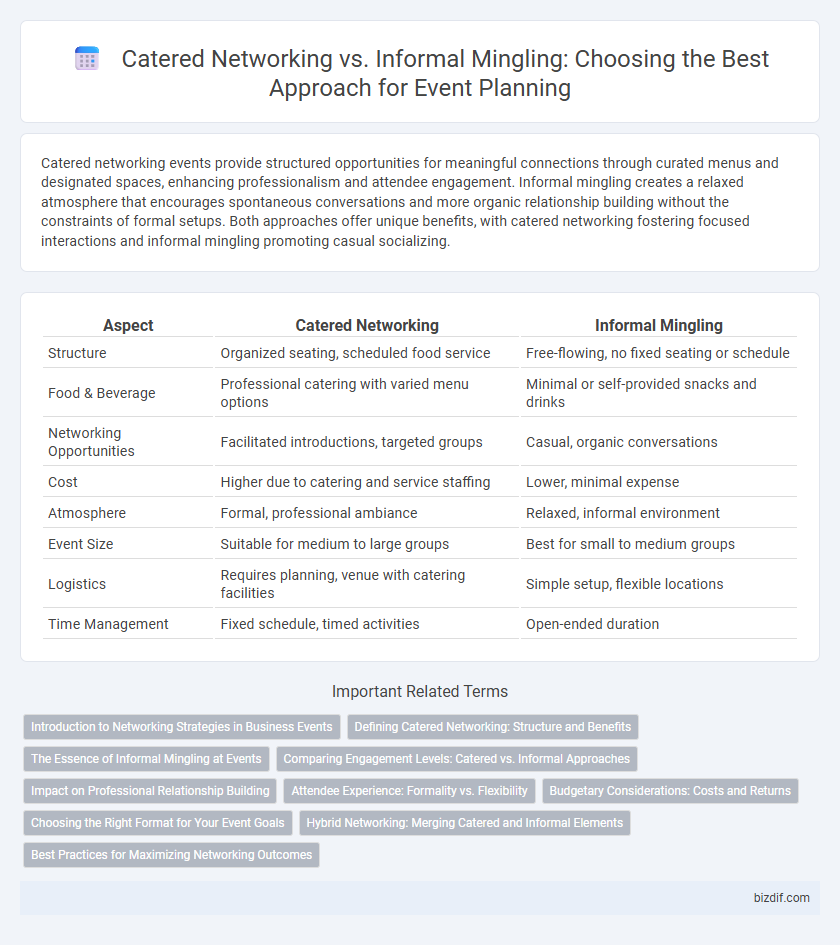Catered networking events provide structured opportunities for meaningful connections through curated menus and designated spaces, enhancing professionalism and attendee engagement. Informal mingling creates a relaxed atmosphere that encourages spontaneous conversations and more organic relationship building without the constraints of formal setups. Both approaches offer unique benefits, with catered networking fostering focused interactions and informal mingling promoting casual socializing.
Table of Comparison
| Aspect | Catered Networking | Informal Mingling |
|---|---|---|
| Structure | Organized seating, scheduled food service | Free-flowing, no fixed seating or schedule |
| Food & Beverage | Professional catering with varied menu options | Minimal or self-provided snacks and drinks |
| Networking Opportunities | Facilitated introductions, targeted groups | Casual, organic conversations |
| Cost | Higher due to catering and service staffing | Lower, minimal expense |
| Atmosphere | Formal, professional ambiance | Relaxed, informal environment |
| Event Size | Suitable for medium to large groups | Best for small to medium groups |
| Logistics | Requires planning, venue with catering facilities | Simple setup, flexible locations |
| Time Management | Fixed schedule, timed activities | Open-ended duration |
Introduction to Networking Strategies in Business Events
Catered networking at business events facilitates structured interactions by providing designated areas and refreshments, encouraging purposeful conversations among attendees. Informal mingling promotes organic connections through unstructured settings, allowing participants to engage spontaneously and build rapport. Combining both strategies enhances overall networking effectiveness by balancing planned opportunities with natural social dynamics.
Defining Catered Networking: Structure and Benefits
Catered networking involves organized events where food and beverages are provided to create a structured environment for professional interactions, enhancing attendee engagement. This setup encourages purposeful conversations by facilitating introductions and networking opportunities through designated seating or scheduled activities. Benefits include increased attendee satisfaction, improved brand perception, and higher chances of meaningful connections compared to informal mingling.
The Essence of Informal Mingling at Events
Informal mingling at events fosters organic connections by removing structured barriers, encouraging spontaneous conversations among diverse attendees. This natural interaction promotes deeper relationship-building and authentic engagement, often leading to unexpected collaborative opportunities. The relaxed atmosphere enhances attendee comfort, making networking more effective and memorable compared to formally catered sessions.
Comparing Engagement Levels: Catered vs. Informal Approaches
Catered networking events create structured environments that encourage meaningful interactions through assigned seating and curated food options, boosting attendee engagement by sustaining energy levels and conversation flow. Informal mingling promotes spontaneous connections but often results in shallow exchanges due to lack of organized facilitation and potential social cliques. Data from event studies reveal that structured catering increases average engagement time by 35% compared to informal setups, highlighting its effectiveness in deepening professional relationships.
Impact on Professional Relationship Building
Catered networking events create structured environments that facilitate targeted interactions, promoting meaningful professional connections and enhancing relationship depth. Informal mingling offers flexibility and spontaneity, encouraging organic relationship development but may result in less focused engagement. Choosing the right format directly influences the quality and longevity of professional relationships formed.
Attendee Experience: Formality vs. Flexibility
Catered networking events provide a structured environment where attendees can engage with curated groups, enhancing targeted professional connections through planned seating and scheduled interactions. Informal mingling prioritizes flexibility, allowing participants to move freely and initiate spontaneous conversations, fostering a relaxed atmosphere conducive to organic relationship-building. Balancing formality and flexibility directly influences attendee satisfaction, with catered settings appealing to those seeking purposeful engagement and informal mingling attracting individuals favoring casual social dynamics.
Budgetary Considerations: Costs and Returns
Catered networking events typically incur higher costs due to professional catering, venue fees, and structured programs, but often yield greater returns by fostering meaningful connections and promoting brand visibility. Informal mingling minimizes expenses through casual settings and self-service options, yet may deliver less predictable networking outcomes and reduced engagement. Evaluating budget constraints against desired event goals ensures an optimal balance between investment and return in event planning strategies.
Choosing the Right Format for Your Event Goals
Catered networking events provide structured opportunities for meaningful connections through planned seating and curated menus, enhancing attendee engagement and facilitating targeted conversations. Informal mingling promotes a relaxed atmosphere where spontaneous interactions and organic relationship-building occur, ideal for creative brainstorming and less rigid networking goals. Selecting the right format depends on event objectives, whether prioritizing focused business development or fostering casual social exchanges among participants.
Hybrid Networking: Merging Catered and Informal Elements
Hybrid networking events combine the structured benefits of catered networking, such as planned meet-and-greet sessions and professional food service, with the relaxed ambiance of informal mingling where spontaneous conversations flourish. This approach maximizes attendee engagement by offering designated networking opportunities alongside casual interactions, fostering both meaningful connections and organic relationship building. Incorporating varied elements like strategically placed food stations and flexible seating arrangements enhances comfort and accessibility, driving higher satisfaction and prolonged participation in hybrid networking environments.
Best Practices for Maximizing Networking Outcomes
Structured catered networking events enhance opportunities for meaningful connections by providing designated times and spaces for focused interactions, supported by curated seating arrangements and icebreaker activities. Informal mingling fosters organic relationship building through relaxed environments but benefits from strategic facilitation such as clear event flow and subtle prompts to encourage engagement. Combining both approaches with targeted follow-ups and attendee profiling maximizes networking outcomes by balancing spontaneity with purposeful interaction.
Catered networking vs informal mingling Infographic

 bizdif.com
bizdif.com